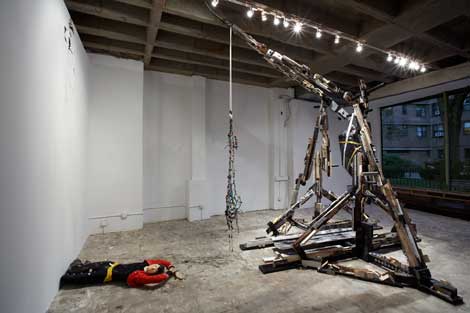Painting is like the proverbial zombie. It’s supposed to be dead but it won’t lie down. The last 50 years in British art has been something of a paint-splattered war zone. Against the odds of prevailing abstraction, Pop and Conceptualism, painters such as Francis Bacon and Lucian Freud continued to paddle their own figurative canoes and create a dialogue with both art history and the body. In his über-gallery in Chelsea, that part of town which hasn’t seen any real artists since the ’60s and is now homeland to Russian oligarchs buying up swathes of London, Saatchi’s show, “Body Language,” explodes with a mix of the good, the bad and the ugly. There is, of course, a certain prurient irony in the title, given Saatchi’s hands around the throat of his now ex-wife Nigella Lawson, recently the subject of pages of press coverage.
Irony and cool still tiresomely dominate as in Dana Schutz’s Martin Maloney–style paintings of surreal picnics and self-devouring heads, or Michael Cline’s Otto Dix–inspired street scenes of societal breakdown and Eddie Martinez’ sloppy sub-Basquiat paintings, full of popular culture clichés, where art allusion supposedly meets the carnivalesque. In his bombastically large “Last Supper” (The Feast, 2010)—who does he think he is, Leonardo Da Vinci?—we are left sniggering (or sighing) as we spot Jesus as a red-nosed clown sitting amid Donald Duck and an alien. Everything reminds me of something else. Jansson Stegner’s elongated police ladies lying in languid poses, armed with phallic batons, are a cross between John Currin and The Death of Chatterton, an oil painting by the English pre-Raphaelite painter Henry Wallis. And Maikiko Kudo’s landscapes, with their lurking Manga pre-pubescents, borrow heavily from Peter Doig but with that added pedophilic twist so characteristic of much contemporary Japanese art.

Installation view, Marianne Vitale & Denis Tarasov
©Sam Drake, 2013
Image courtesy of the Saatchi Gallery, London
Western painting has a long historical tradition of depicting women. British artist Chantal Joffe’s derive from photographs but her fluid paint presents her subjects as wary and guarded rather than as objects for the male gaze. Particularly effective is her wall installation of small paintings, many of children, that mimics a photograph album. Uncanny and slightly disturbing, there’s a touch of Diane Arbus or Alice Neel about them. And there are a lot of U.S. artists, including the over-hyped Henry Taylor, with his flat, I-can’t-be-arsed-to-paint-any-better-than-this-or-it-just-wouldn’t-be-hip paintings. One shows two young black men strutting down the street with a disturbingly big dog. One has a towel over his shoulder, the other swigs from a bottle.
Some of the most arresting work is not painting but photography, such as the large C-prints of Russian gravestones by Denis Tarasov. The deceased are shown as they would like to be remembered. Mobster suits and fast cars, headscarves and jewelry or sitting in front of abundantly laid tables with champagne and bowls of fruit, like some Renaissance vanitas painting. And there is some truly horrible sculpture by the American Nathan Mabry. A pair of pre-Columbian–inspired skeletons sit crouched on top of a Donald Judd–style base, playing tongue tennis with their little flappy brass appendages. One has an erect penis under his tunic. In an act of hubris this is cast in bronze—it will be here forever. Justin Matherly’s contorted body shapes that wrap themselves ambiguously around Zimmer walking frames are made of pock-marked concrete. Though effective, I couldn’t help thinking of Louise Bourgeois and Sarah Lucas. Elsewhere there’s a whole gallery of Marianne Vitale’s gravestones. Made from reclaimed lumber they retain the notches and burn marks of their previous history. Certainly they evoke human presence, a lost crowd of the deceased. But why so many? The point would have been made with half the number.

Andra Ursuta, Vandal Lust, 2011, Trebuchet: wood, plastic, cardboard, elastic, rope, metal; Body: foam, plastic, fabric, leather, wax, © Andra Ursuta, 2011
Image courtesy of the Saatchi Gallery, London
This is a mishmash of a show. As if Saatchi is hedging his bets, just in case one of the artists should become the next big thing. This makes it what it really is—a commercial exhibition, despite the museum grandeur of the building.
But there is one work I did find affecting. It takes up the whole final room. Andra Ursuta has put together a giant jerry-built trebuchet from bits of wood and cardboard like a child’s construction model. Hanging from it is a broken rope harness, while the opposite wall is damaged as if by a blow. Below lies a prone babushka figure. What has happened to her? There’s a frisson here between the Buster Keaton humor and the implicit tragedy. Ursuta’s childhood in Romania was much affected by the antics of the Soviet Union. Across the gallery is Crush, a flattened body, dark and leathery as if found in some Iron Age peat bog. It is a cast of the artist’s own body and lies squashed and flat on its back. Naked except for childish braids and trainers it has been splattered with artificial seminal fluid. This prostrate figure, which reaches back into the bogs of history and is a reminder of the violence still raging in parts of the world, stands out strongly amid the narcissistic razzmatazz of the rest of the show.


